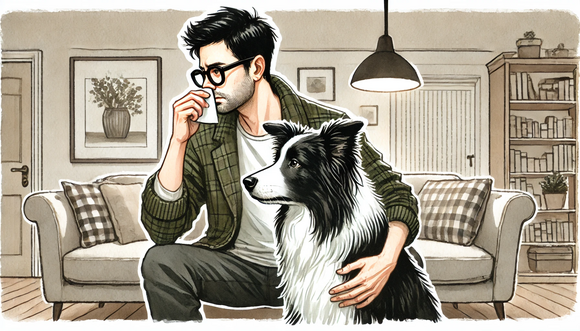Allergic to your own dog? How to master the challenge

Symptoms of a dog allergy
A dog allergy manifests itself in a similar way to other inhalant allergies and can cause a variety of symptoms. Typical signs are
- Respiratory tract: Sneezing, coughing, allergic rhinitis, shortness of breath and even allergic asthma
- Eyes: watery, itchy or burning eyes
- Skin: itching, swelling, reddening of the skin and eczema
- General: concentration and sleep disorders
These symptoms occur due to contact with dog allergens found in your dog's dander, saliva and urine.
Diagnosis of a dog allergy
If you suspect that you are allergic to your dog, you should consult an allergist. Diagnosis usually involves skin tests (such as the prick test) and blood tests that check for specific antibodies to dog allergens.
Treatment options
Allergen avoidance
The safest way to treat an allergy is to avoid the allergens. However, this does not necessarily mean that you have to separate yourself from your dog. You can take some measures to reduce exposure to allergens:
- Living spaces: keep the dog out of the bedroom and other rooms where you spend a lot of time. Vacuuming regularly and using air filters can also help.
- Hygiene: Wash your hands after every contact with the dog and wash your clothes regularly. Frequent bathing of the dog can also reduce allergen exposure.
- Textiles: Use allergy-friendly covers for beds and upholstered furniture and clean them regularly.
Medication
There are various medications that can alleviate the symptoms of a dog allergy:
- Antihistamines: these medications block the effect of histamine, a substance that triggers symptoms in allergy sufferers.
- Corticosteroids: These can be used in the form of creams, nasal sprays or tablets to reduce inflammation.
- Decongestants: These help to clear blocked noses, but should only be used in the short term.
Desensitization
Desensitization or hyposensitization is a long-term therapy in which the immune system is slowly accustomed to the allergens. Over a longer period of time, the body is given increasing amounts of the allergen in order to develop tolerance. This therapy can take several years, but offers the chance to permanently reduce the allergy.
Tips for everyday life with dog allergies
Choice of dog breed
Some dog breeds produce fewer allergens than others. Breeds such as Poodles, Maltese or Bichon Frisé are often more suitable for allergy sufferers as they shed less hair and therefore spread fewer allergens. However, it should be noted that there are no truly allergen-free dogs.
Regular grooming
Regular grooming and frequent bathing of your dog can help to reduce the amount of allergens in your household. Brushing outside also helps to reduce the amount of hair and dander that ends up in your home.
Stress management
Stress can exacerbate allergy symptoms. It is therefore important to ensure a stress-free environment for you and your dog. Relaxation techniques and regular exercise can help to strengthen the immune system and alleviate allergy symptoms.
Conclusion
A dog allergy does not necessarily mean that you have to part with your beloved four-legged friend. With the right diagnosis, treatment and a few adjustments to everyday life, you can successfully manage the allergy symptoms and continue to lead a happy life with your dog.
If you are still unsure or cannot get the allergy symptoms under control, it is advisable to consult an allergist and find a suitable solution together.
More articles for you
Contact form problem fixed
Unfortunately, our contact form has not worked as desired in recent weeks. 😔 Due to an error in the spam detection, normal messages were also incorrectly filtered out.Read moreDangerous encounter: What you should do if your dog is bitten by a snake
It's every dog owner's nightmare: you're out in nature with your four-legged friend, he's sniffing the ground curiously, and suddenly you hear a hissing sound. Before you know it, your dog flinches and you recognize the signs of a snake bite. But don't panic! In this article, you will learn how to…Read moreWhat you should know about cherries for dogs
You may have heard that cherries are good for your health. They contain lots of vitamins, antioxidants and fiber, which can strengthen the immune system and aid digestion. But are cherries also suitable for dogs? And if so, how much and in what form should you offer them to your four-legged friend?…Read more


